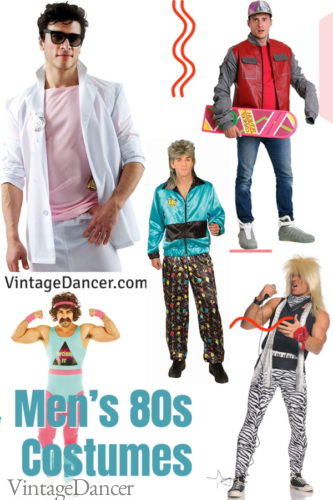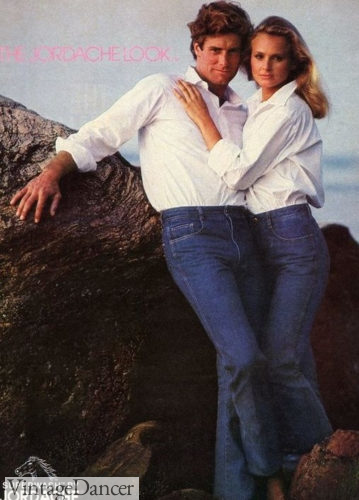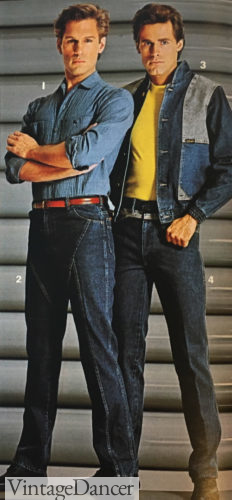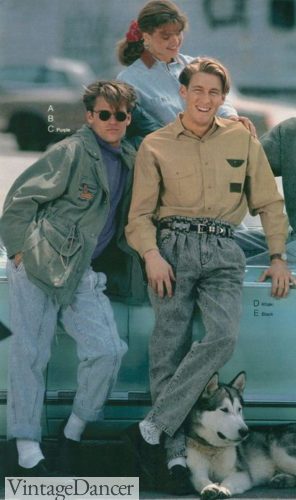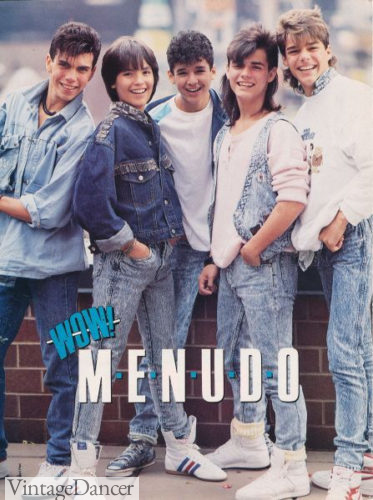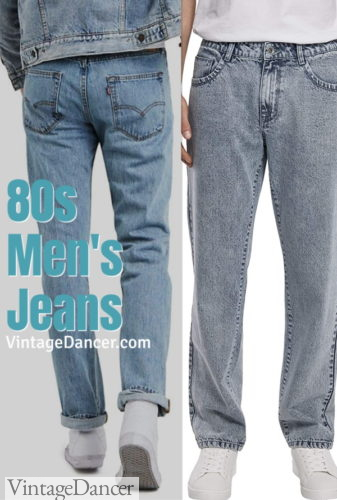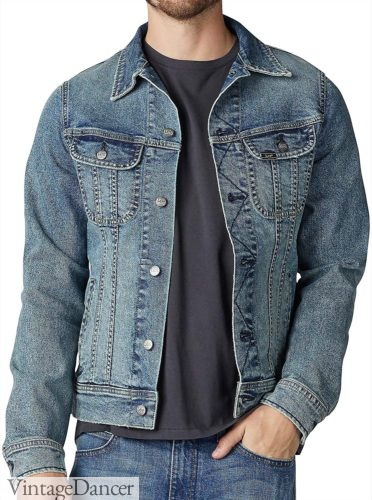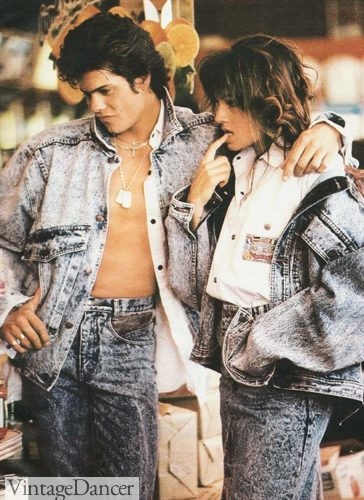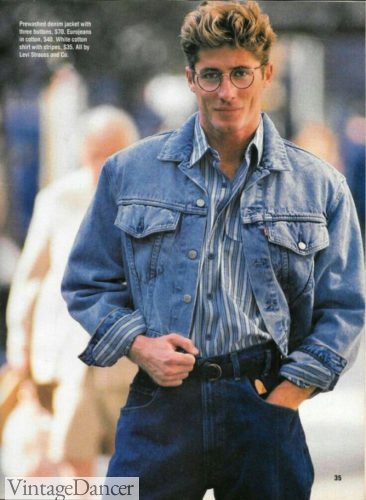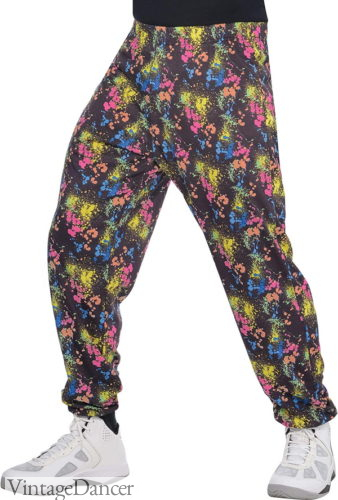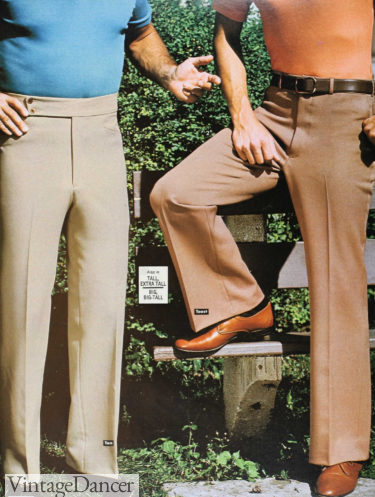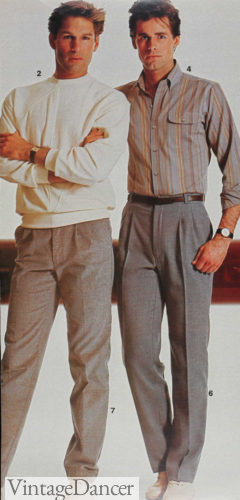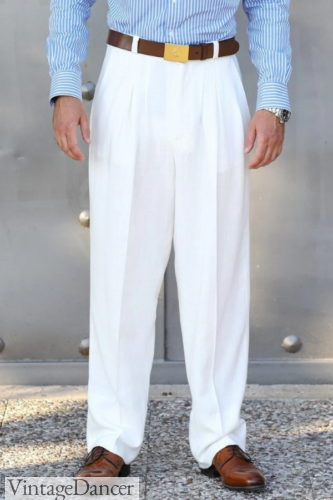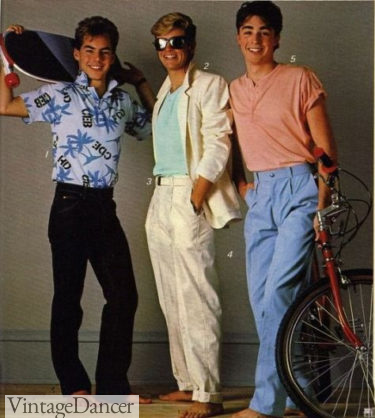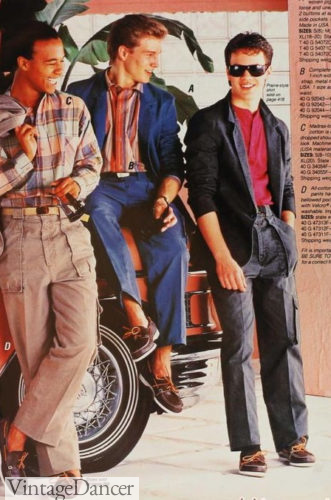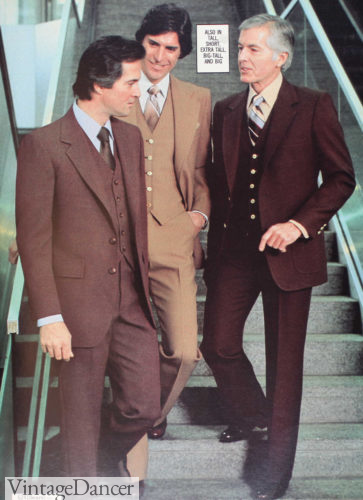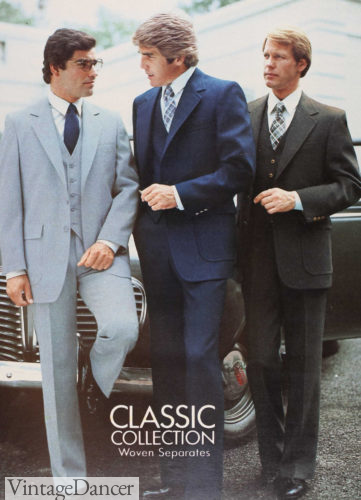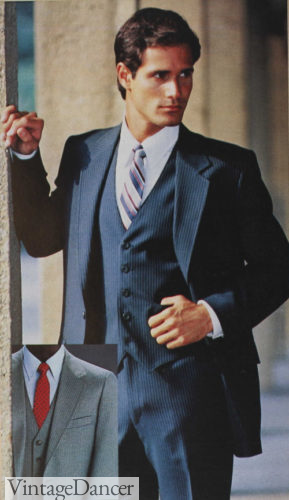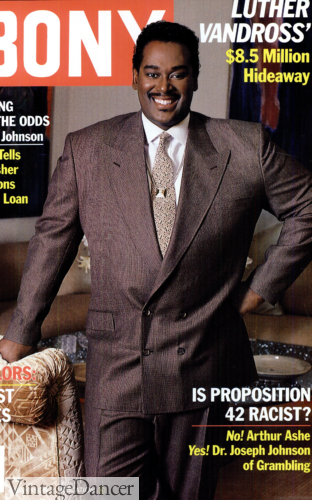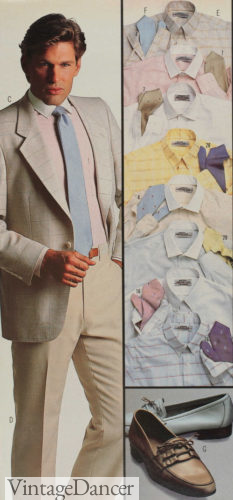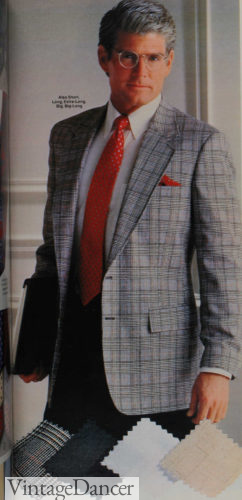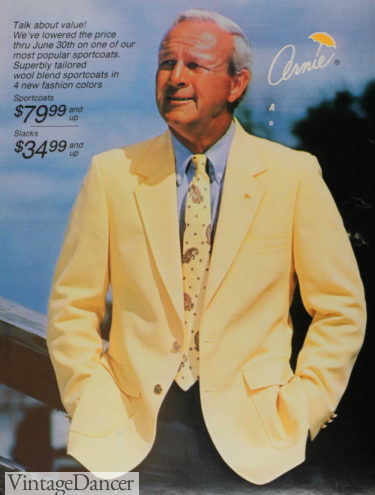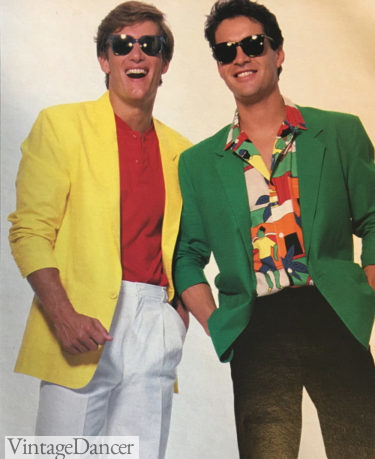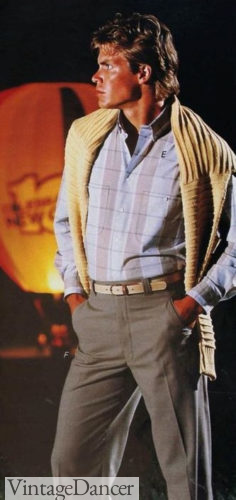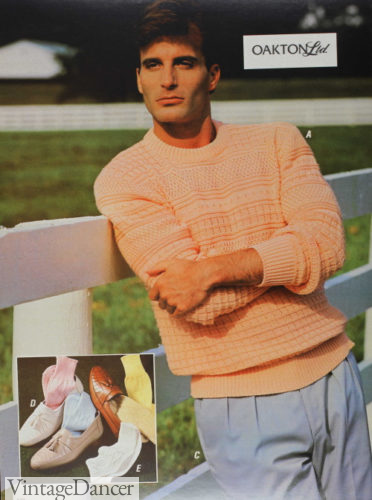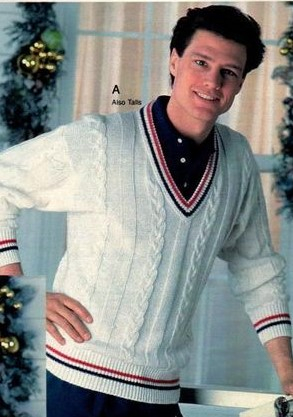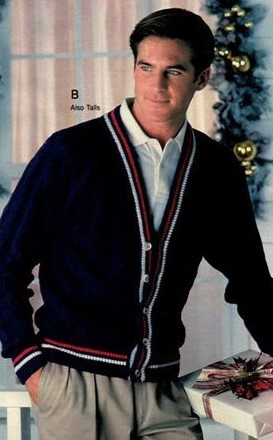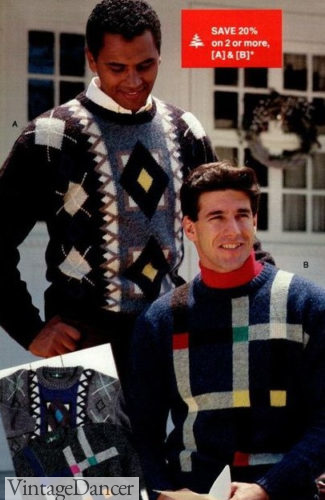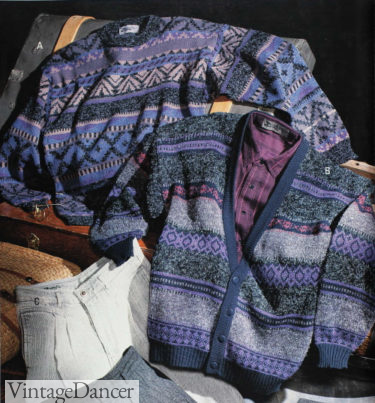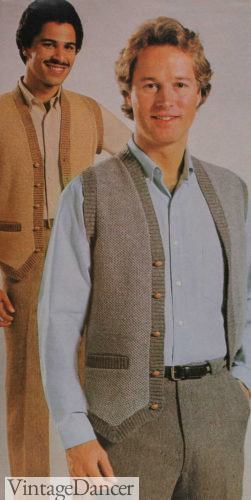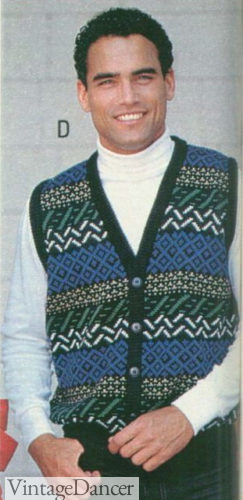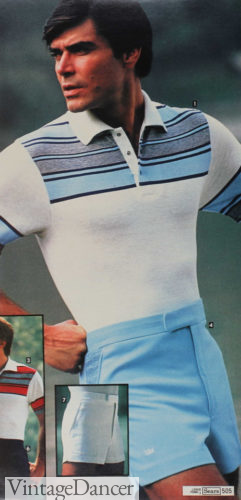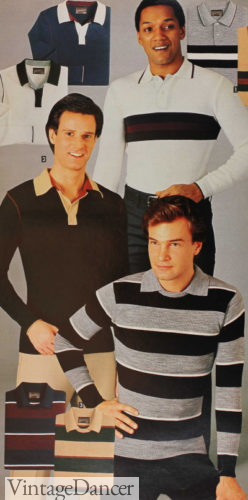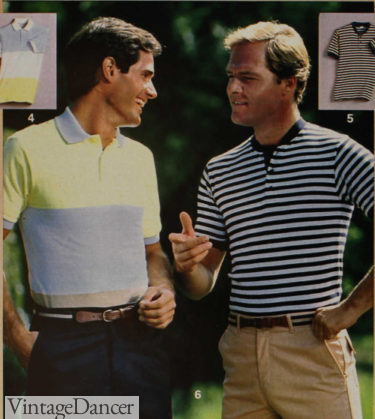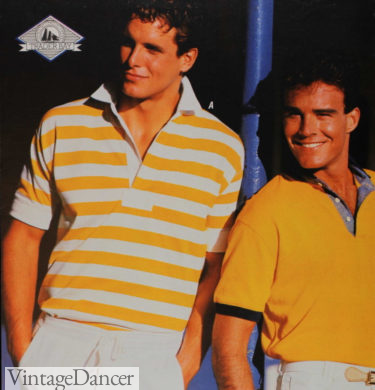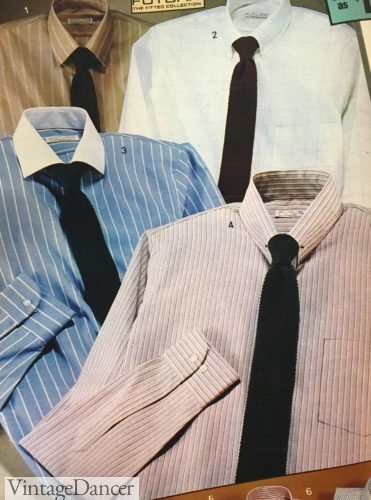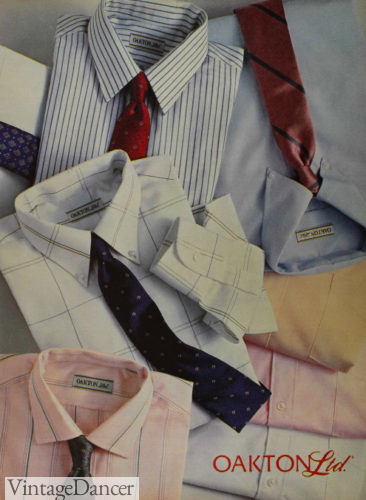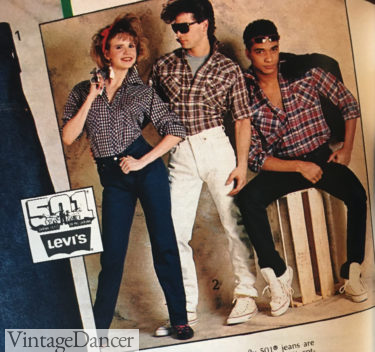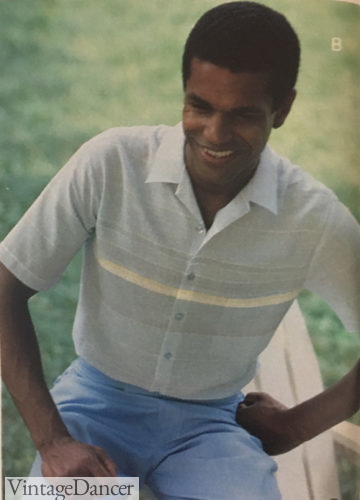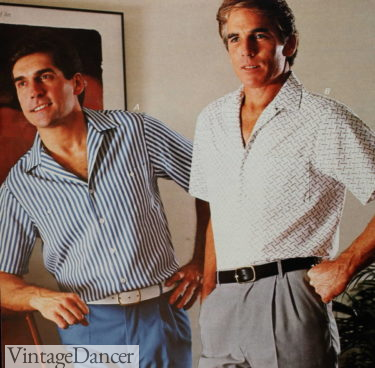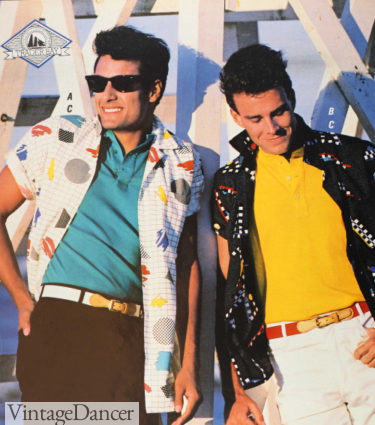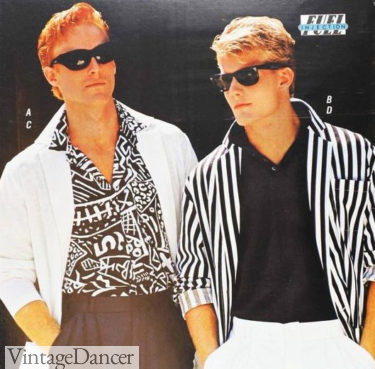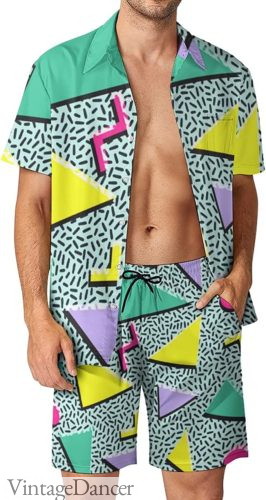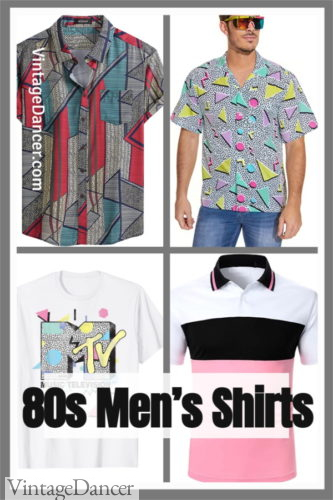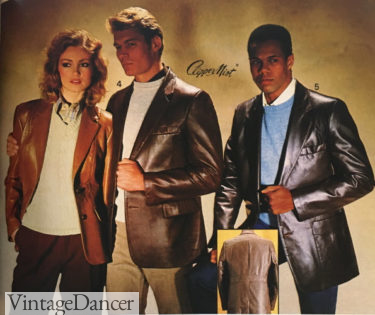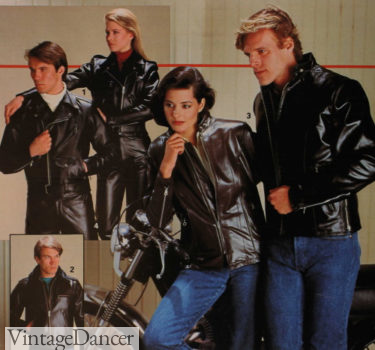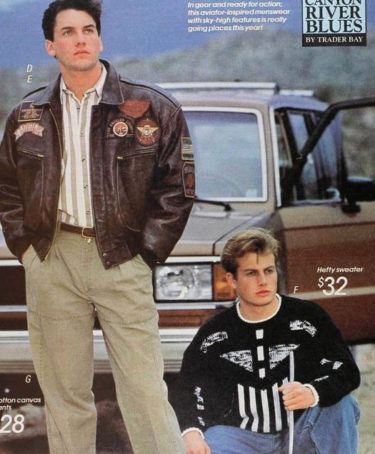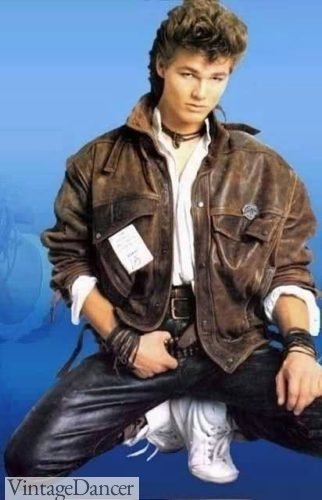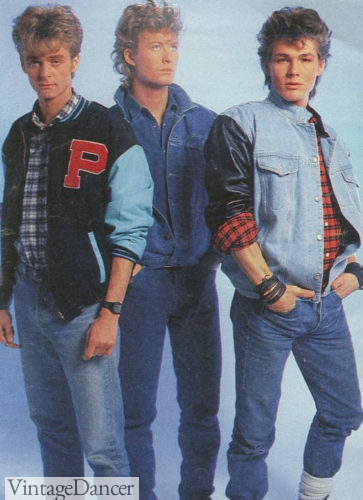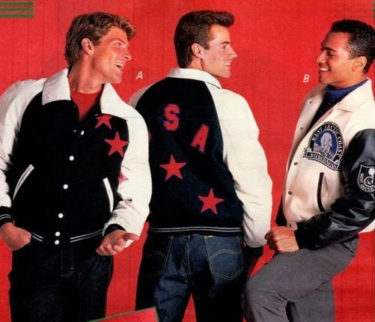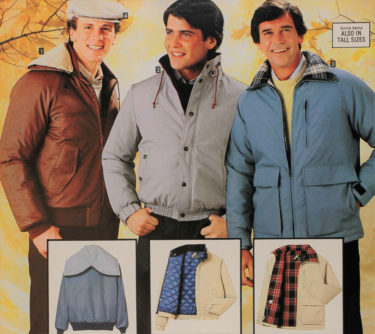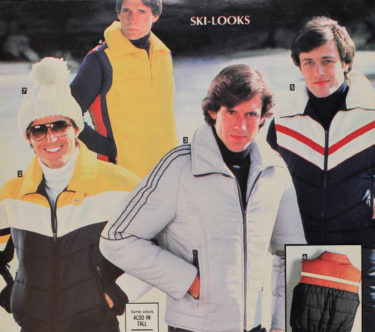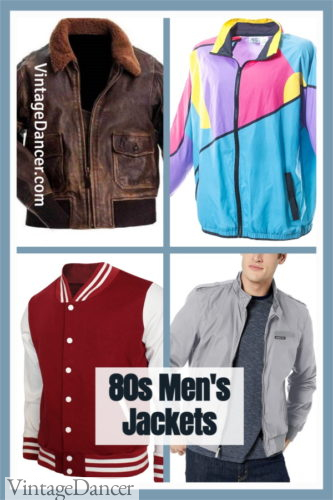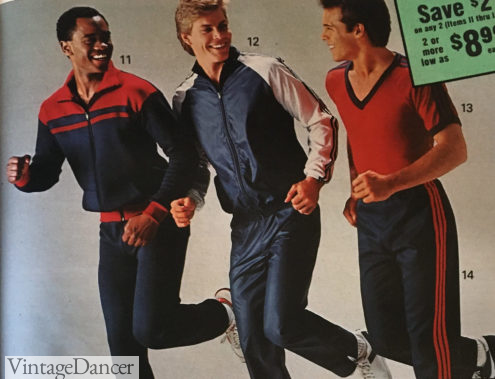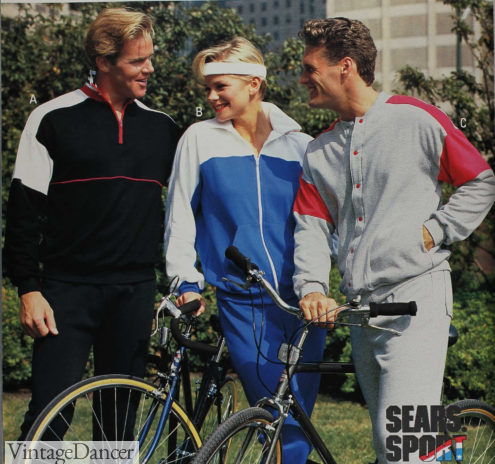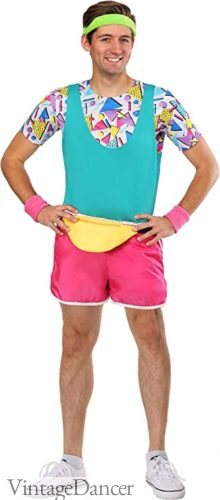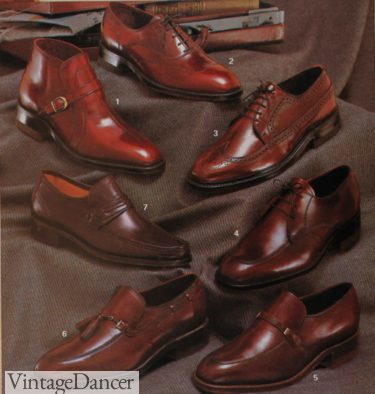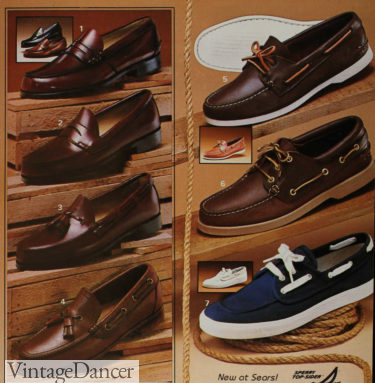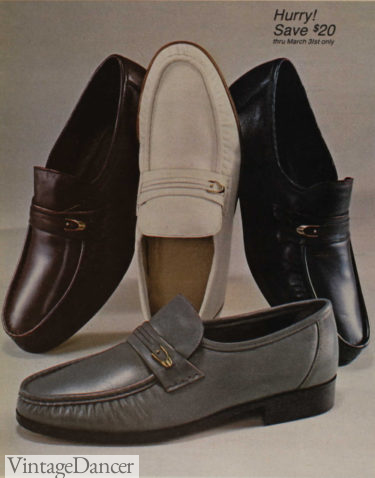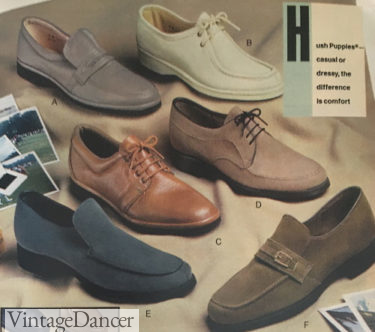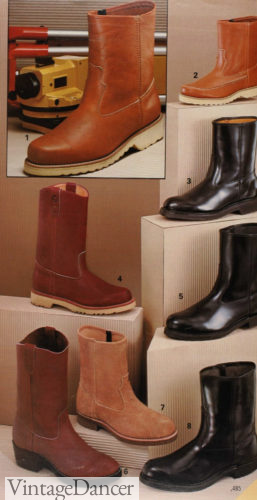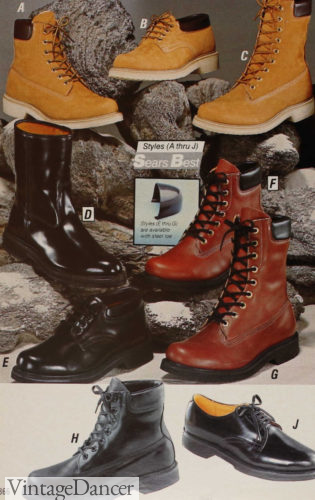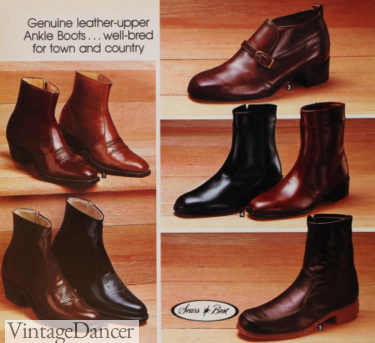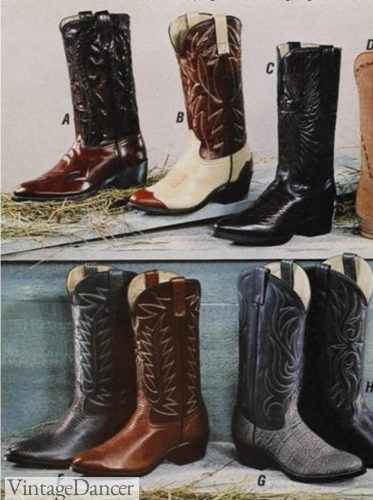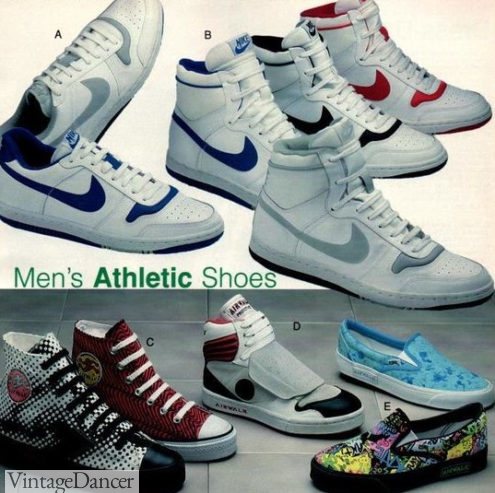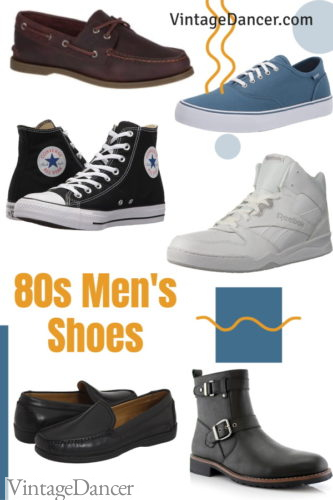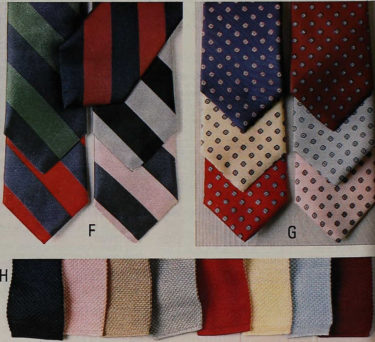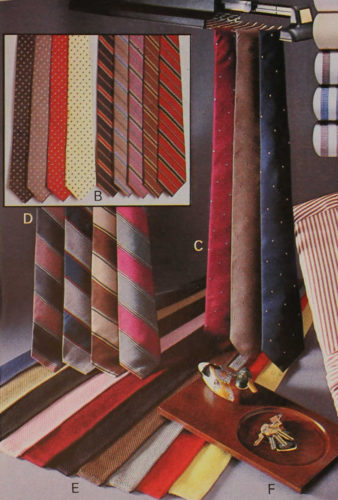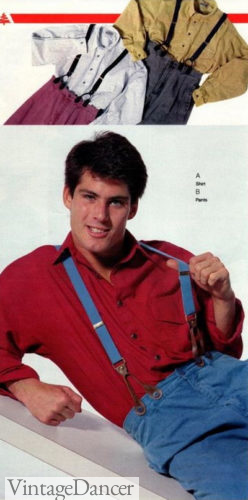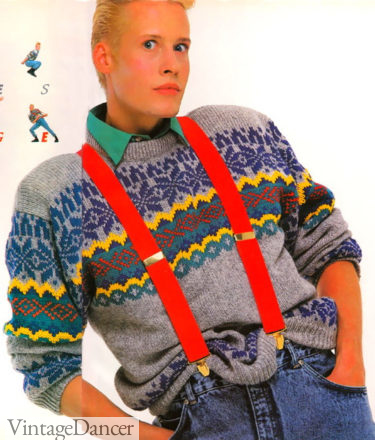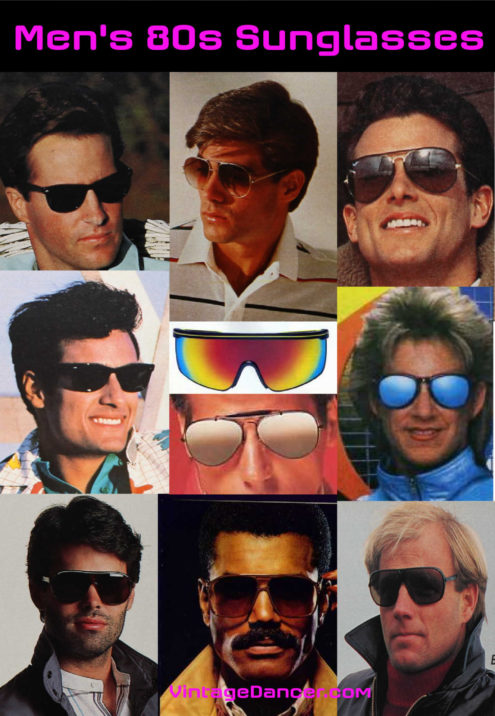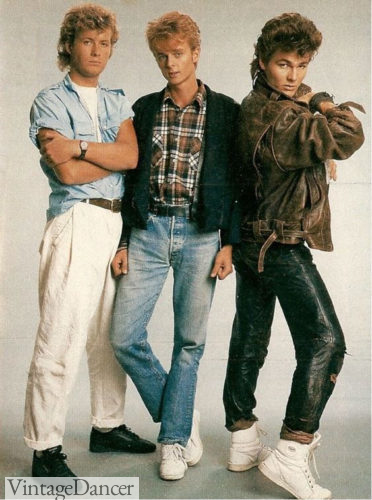
Young men’s cotton pants, denim jeans and leather with layered shirts and jackets. Not to mention the totally awesome 80s hair!
While men’s fashion didn’t change as dramatically throughout the 20th century as women’s fashion, 1980s men’s fashion trends and styles developed new looks alongside a resurgence of older styles.
For the most part, 1980s fashion for mature men settled back down from the flamboyant fashion of the ‘70s and closely resembled men’s classic styles of the 1940s-1950s. Pastel sportswear, conservative suiting, and even Hawaiian shirts were back in style.
–>Skip the history and shop for ’80s inspired men’s clothing and men’s 80s -90s costumes:
Shirts | Sweaters | Pants | Shoes | Jackets | Costumes | More
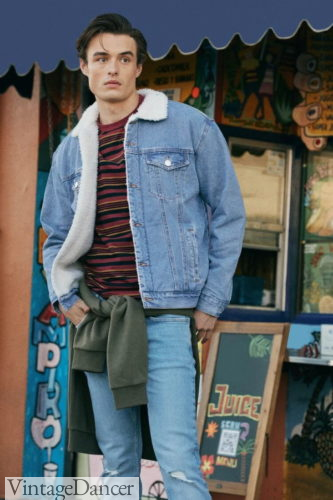
80s outfit, trendy today. Buy 80s style clothes.
Young men’s fashion, on the other hand, was bold, colorful, and athletic. ’80s guys wore layers of denim, baggy jackets, leather goods, workout clothes, and sneakers.
Most teens and college kids adopted one of several key looks: the prep, the rocker, the athlete, the cool dude, the surfer, or the urban cowboy. Each had a distinct style, yet they all borrowed elements from each other.
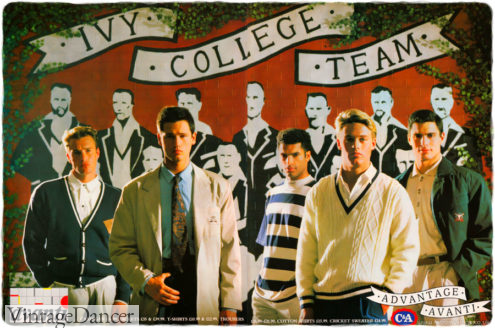
1989 Ivy style with collegiate sweaters
The following is an overview of clothing worn by teen guys to mature men’s fashion of the ‘80s, focusing on the everyday fashions. If you want to look at rocker, punk, goth, or hip hop sub-genres, you won’t find much of that here. But if you need an 80s Halloween costume– we have links to all of it.
80s Men’s Pants and Jeans
For ’80s men, loose and baggy styles dominated the jeans market. Levi’s, Lee, and Wrangler were popular brands with men while Jordache, Guess, and Calvin Klein were preferred by trendy younger guys. Jeans had a moderate waist (down from the higher waisted ’70s pant) with either a classic straight leg or a tapered leg for the cooler set.
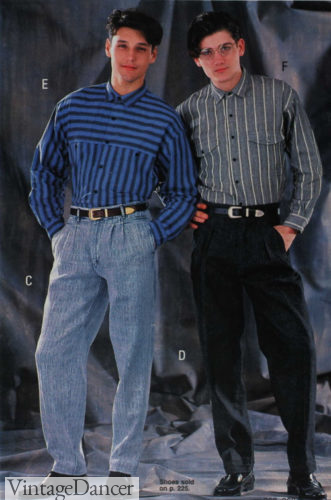
1989 long sleeve stripe shirts with yoke front pants and western belts.
What made ’80s jeans unique to the decade was the fabric treatment and the waistband.
Dark to medium wash blue denim was a standard option for basic jeans such as Levis 501’s, but the best men’s ’80s jeans had a stone wash or acid wash treatment that gave blue or black jeans a marbled effect. Colors spanned almost all white, grey/black, and washed out denim blue. So cool!
- Jordache ’80s men’s straight leg jeans
- 1985 men’s Wrangler jeans
- Pleated men’s acid wash jeans
- Acid wash jeans worn by the band Menudo
The other men’s 80s blue jean feature was the waistband treatment. To appear baggier and looser, men’s jeans were often pleated at the waistband, just like “old men’s trousers” used to be in the 1940s. Waistbands could also be gathered on elastic for pull on jeans.
Waistband styling was also borrowed from western wear, placing a yoke front on baggy jeans. Cargo pockets were added to many pants and jeans in the mid to late ’80s.
80s men’s denim overalls, jackets, vests, and shirts were also fashionable during the ‘80s. Overalls were worn primarily as fashion by women, but as functional workwear by men.
Denim jackets and vests were typically worn by young men and teens. They were available in light to dark washes and colors, and were frequently paired with denim jeans in a matching or coordinating wash/color for a denim-on-denim look.
The ’80s denim jacket was oversized and baggy, with an excess of pockets and brass buttons. Some were lined in a contrasting fabric so the cuffs could be flipped back on the wrist.
Shop 80s denim jackets and vests.
- Men’s acid wash jeans and denim jacket
- Levis’ denim on denim look
Another pants style that saw its rise in the ‘80s was parachute pants. Parachute pants were slim-cut nylon pants with lots of zippers on the legs. They were popular with Techno music breakdancers before entering mainstream fashion, usually paired with a T -shirt.
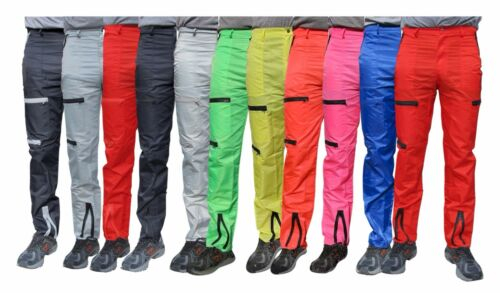
Reproduction 80s parachute pants. Shop them here on Ebay
The term “parachute pants” is sometimes used to refer to Hammer pants or harem pants, which are very full pants that taper at the ankles popularized by MC Hammer. These were also sometimes made of nylon “windbreaker” material, further adding to the name confusion. This is not the same style that was popular in the ‘80s; harem pants were more of a early ‘90s trend.
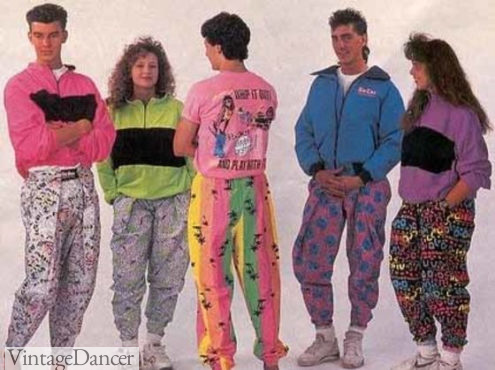
1992 nylon harem pants, not parachute pants. Shop here.
As popular as denim pants were, double knit polyester, cotton twill, corduroy, and various wool dress slacks materials made up the other half of men’s pant fashions. Slacks and dress pants for men usually hit at the natural waist and were loose throughout the seat and thigh, with a straight leg.
- 1984 men’s casual pants, flat front
- 1985 pleated men’s pants
Slim cut pants hit below the natural waist and were more fitted in the seat and thigh. At the beginning of the decade, pleated front and flat front pants were both prevalent, but by the end of the decade, most men were wearing flat front pants.
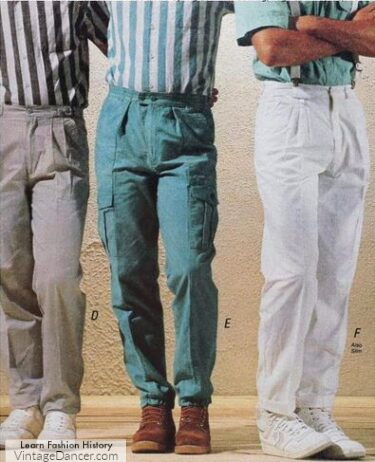
1988 pleated pants, cargo pockets
‘80s men’s slacks and dress pants came in black, khaki, tan, navy, and gray, white as well as in “fashion colors” to match suit jackets and coordinate with patterned sport coats (pastels, cream, neutral tones, etc). Most pants in the ‘80s did not have pressed cuffs but rolling cuffs was very trendy.
- Pleated cotton pants
- 1987 twill cargo pants
In the summer, men had plenty of options for shorts. The ‘70s trend for shorter shorts for men continued into the ‘80s and was especially popular with younger men. These men’s 80s shorts typically hit at mid-thigh and came in a rainbow of colors and materials (knit, cotton, denim).
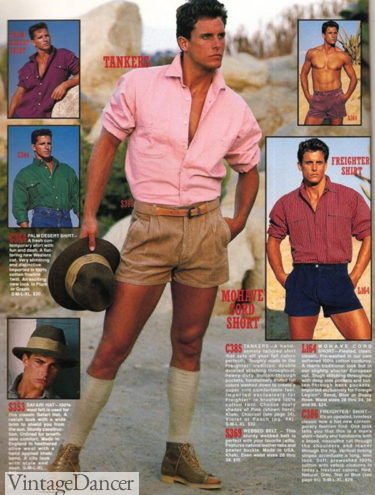
1986 Hiker / safari style shirts and shorts
Men’s 1890s shorts were flat fronted and typically paired with coordinating button-down, pullover or knit shirts. For the mature man, traditional knee-length shorts were available, also in a rainbow of colors to match any top.
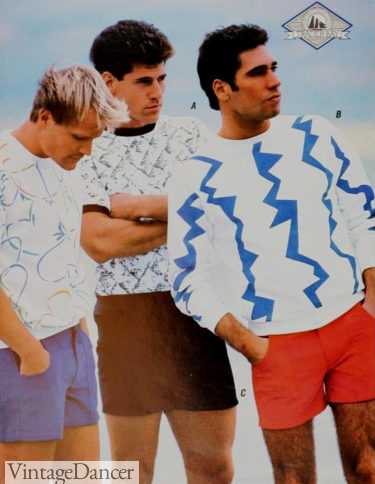
1987 colored twill shorts with T shirt and sweatshirt
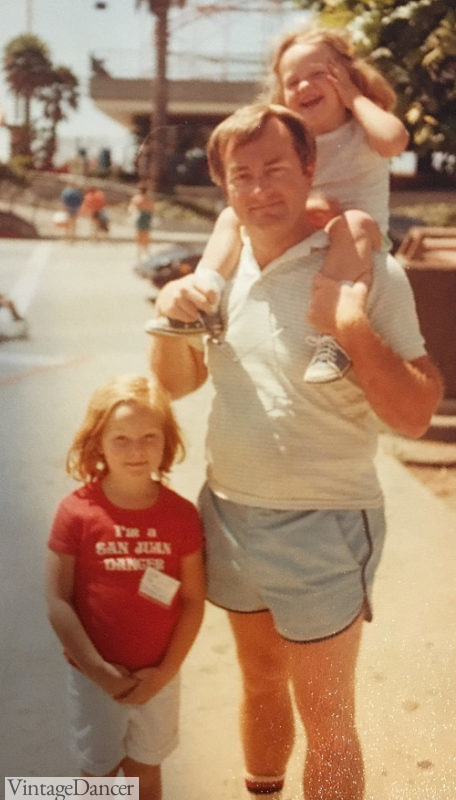
My dad, rocking dolphin shorts and polo shirt in 1984
1980s Men’s Suits/Business attire
Men’s suits in the ‘80s were cut full, with wide shoulders accentuated with shoulder pads. For older men or men who worked in the most conservative workplaces, 3-piece suits (jacket, pants, and vest) were still widely worn. A slightly more “relaxed” or younger look was the 2-piece suit, just a jacket and slacks. By the end of the decade, the 2-piece suit dominated.
- 1980 natural colored 3 piece suits
- Mid 1980s men’s three-piece suits
- 1984 pinstripe suit
- 1989 deep V double breasted trendy suit
Most suit jackets or sport coats in the ‘80s were single breasted, although there were some double-breasted options available. Jackets were worn with matching colored slacks as a suit, or with coordinating or contrasting slacks as a sport coat with slacks. Patterned sport coats were worn for a more casual look. Patterns available included checks, plaids, windowpane plaids, pinstripes, houndstooth and herringbone. Bright and solid colors were equally popular in summer. The end of the decade saw the oversize deep V double breasted suit in a distinct pattern come into fashion.
- 1985 sport coats and slack with pastel white collar shirts
- 1989 plaid sport coat
Men’s 1980s suits also came in a variety of colors; traditional colors such as black, navy, and gray, but also light green, sky or baby blue, tan, burgundy, cream/white or brown. Polyester, wool, wool blends, and corduroy were common materials for winter jackets, while summer jackets were often linen, linen blend, polyester, or silk. Most jackets had an acetate or rayon lining, but high-end jackets could have silk lining. “Fashion” jackets made of denim, leather, and suede were also available, but not as widely worn.
Younger and older men wore sport coats and blazers differently. Older men paired them the traditional way with dress shirt and tie or a polo shirt for something a bit more casual. Young men wore loose, unlined sport coats/blazers over T-shirts, tropical camp shirts, Henley shirts, sweaters and sweatshirts (and a rad pair of retro sunglasses). Yet another example of men’s and guy’s 80s fashion using the same styles but layered differently.
- 1987 bright sports coats with dress shirt and tie were favored by mature men
- 1987 yellow and green sportcoats worn with casual shirts and pants for the young men
Summer suits were not only made of lighter fabrics, but also came in lighter colors. Pastel and light tones such as light blue, cream, tan, and “rose” (pink) were widely worn in summer. The all white or cream suit or sport coat with coordinating pants, when paired with a tropical shirt, reflected the clothing worn in the popular TV show Miami Vice. Every “cool” man had to had one Miami outfit for summer.
Shop vintage 1980s suits and sport coats on Ebay.
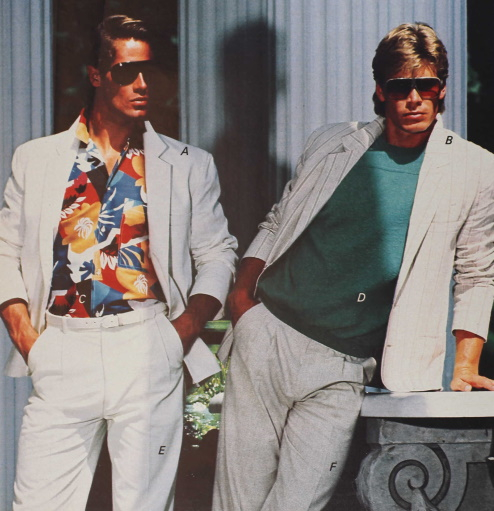
1987 the white suit with casual shirt was a classic “Miami Vice” look in summer
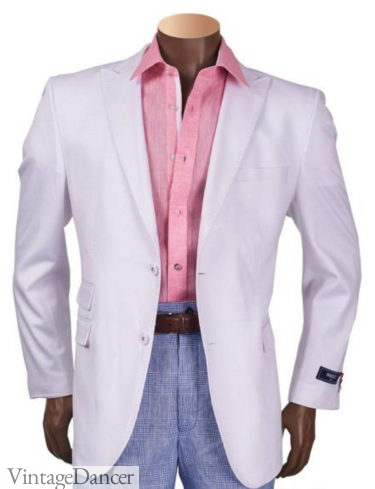
80s Miami Vice style outfit. Shop now.
80s Preppy vs Ugly Sweaters
For preppy men, chunky, hand-knit sweaters were a critical layering piece. Sweaters were typically patterned, either through texture (cable knit) or color (shapes and designs). Most sweaters were a pullover or jumper style without a front opening. Neckline styles included a turtleneck or mock neck, crew, and v-neck. V-neck sweaters were typically worn with a collared shirt, as were some crew neck styles.
- 1986 “Ivy look” outfit with sweater hung over shoulders
- 1988 pastel peach chunky knit sweater is still an preppy look but updated
Alternatives to the traditional pullover style for men included the cardigan and tennis sweater. Cardigans buttoned in the front, with the buttons coming up to mid-chest. They could include texture or color detailing, with rib or cable knitting and contrasting trims.
A tennis sweater had a v-neck with striped ribbing on the edges of the neckline in contrasting colors, usually in red or blue or both. Most were white, off-white, or ivory colored, but could be found in other neutral colors such as gray and navy. A tennis sweater might also have striped ribbing on the cuffs and waistband. Tennis sweaters are a classic style and can still be found today. Pair them with a polo shirt for the country club look.
- 1988 tennis sweater
- 1988 tennis cardigan (note the striped edges)
Most ’80s trendy sweaters were decorated in the form of knitted patterns made of different-colored yarns. These patterns included geometric shapes, stripes, Icelandic and snowflake patterns, abstract designs, and argyle. Patterns could form rows across the torso, radiate from the neckline, or spread across the whole sweater. The more abstract patterns created an era of “ugly sweaters” which have sparked the latest trend for ugly sweater bar crawls and costume parties.
- 1987 geometric print sweaters
- 1989 men’s Zeppelin ski sweaters
Men’s sweaters tended to be in neutrals (black, cream, gray) or primary/bright (blue, green, red), although some could be found in pastels for a summer/Ivy look. Textures were smooth in the early years and rough/chunky in the middle years onward. Men’s 80s sweaters are back in fashion for 2020! Buy 80s vintage style men’s sweaters.
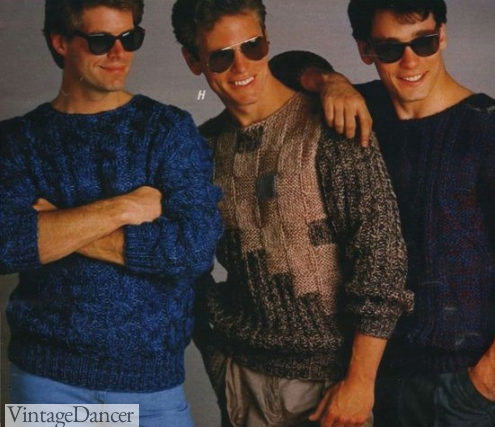
’80s textured men’s sweaters
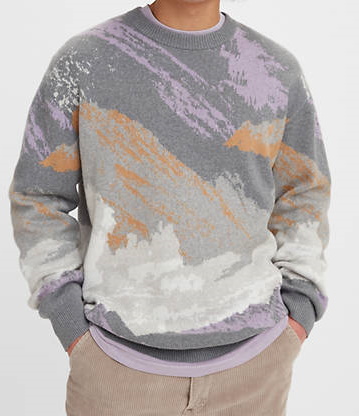
New 80s style sweater by Levis. Shop more sweaters and knitwear.
The sweater vest was another style seen in the ‘80s. Although most sweater vests were v-neck pullovers, some buttoned in the front like a cardigan sweater. They also came in abstract patterns, argyle, Fair Isle, solid pastels, and smooth or cable knits. Sweater vests were mostly a mature man’s choice, worn over a button down shirt. Young men wearing the “Country club” look also wore pastel sweater vests and button down shirts.
Shop men’s sweater vests here.
- 1980 contrast edge cardigan sweater vests
- 1989 fair isle sweater vests
80s Men’s Shirts
One of the most popular shirt styles for men was the polo shirt, which came in various colors — even pink. Horizontally striped polo shirts were especially popular, whether with thick rugby-style stripes, thin stripes in alternating colors, or a solid color body with stripes across the chest. Polo shirts could have contrasting collars, long or short sleeves, and pockets. IZOD or Lacoste shirts were the premium brands.
Polos and most other shirts were worn tucked into waistbands. The banded bottom polo shirt was one exception for mature men, and was worn over the pants waistband.
- 1980 retro stripe polo shirt
- 1981 Long Sleeve Polo Shirts
- 1984 color block and stripe polo shirts
- 1988 guys rugby shirts
Button-down shirts came in all sorts of colors, patterns, and styles in the ‘80s. For work, a man would wear a long-sleeved button-down dress shirt in a light color, such as white, tan, light blue, medium brown, light green, and “light rust” AKA salmon. Some dress shirts had thin pinstripes or contrasting white cuffs and collars. There were also short-sleeved dress shirts for summer wear.
- 1985 men’s button-down shirts with barrel cuffs
- 1988 men’s dressy shirts
For casual wear, button-down short-sleeved shirts with patterns and pockets were widely worn. Patterns included anything from stripes and plaids to paisley and abstract prints. Oftentimes, a striped shirt would have bias-cut pockets, which were cut diagonally on the fabric so the stripes would appear diagonal when the pockets were attached.
Western plaid shirts became trendy after the movie Urban Cowboy released in 1980. Traditional western garb could be worn with them, but the cool kids worn them layered over a T shirt, partially unbuttoned.
- 1989 long sleeve stripe shirts with yoke front pants and western belts.
- 1985 western plaid shirts were cool enough for young guys
Camp collar (revere collar) shirts were very trendy in summer with stripes, solid, tropical prints (Hawaiian shirts). Shop men’s retro shirts here.
- 1986 men’s short sleeve camp collar shirt with horizontal stripes
- 1986 camp collar shirts
“Memphis-style” abstract pattern shirts were trendy in the late ‘80s among teens and young men. They were button-down shirts layered over knit shirts and worn sometimes partially unbuttoned or all completely open, often with rolled sleeves and a flipped up collar. Long sleeve shirts were also rolled up to the elbow.
- 1987 abstract print shirts over t-shirts
- 1987 men’s black and white patterned shirts
The baseball tee, a knit shirt with raglan sleeves in a contrasting color, was a popular shirt among teens and young men. So were T-shirts, Henley shirts, sleeveless shirts, knitted pullover shirts, and sweatshirts – basically every kind of cotton knit shirt you can find today was also worn in the 1980s. Both loose and muscle fit shirts were worn, tucked into pants.
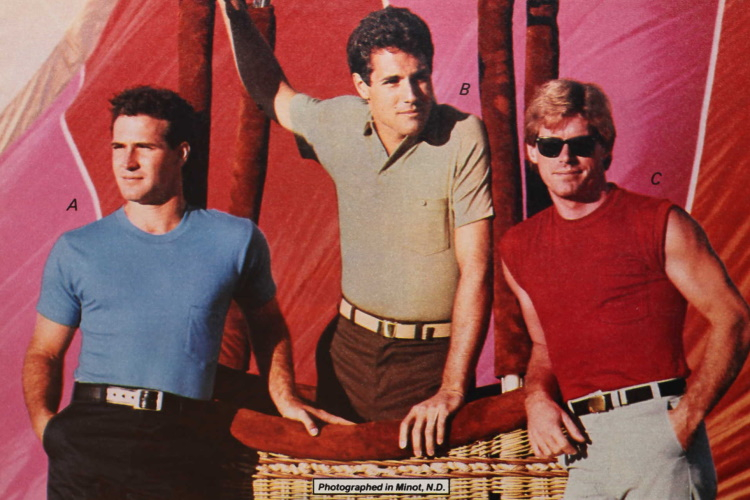
1987 mens muscle T shirts, polo shirts and sleeveless tops
Especially trendy with the younger crowd, graphic tees were a wardrobe staple in the ‘80s. Graphics ranged from messages to product or college logos to cartoon images. Band tees and sports team shirts were widely worn and are some of the easiest styles to replicate today. Pick up a vintage 80s T-shirt on eBay.
Shop new 80s style shirts and T-shirts.
80s Jackets
Men could choose from a variety of leather jacket styles in the ’80s. Popular styles included the traditional motorcycle jacket, the cafe racer jacket (a short, full-zip jacket with a stand collar), the flight jacket (jacket with a spread collar and rib-knit cuffs and lower band) and leather blazers (for the preppy look). Long leather coats and dusters were also available.
- 1985 leather blazers
- 1984 motorcycle leathers
The flight jacket and similar bomber jackets gained popularity among ‘80s men after the release of Top Gun in 1986. Tom Cruise wore a flight jacket in the movie and suddenly, men everywhere were sporting variations of the style. Thick and padded on the inside, they were great for winter wear. Some had sheepskin lining for extra warmth and the “cool” factor.
- 1987 Top Gun-style leather jacket, sweater
- Heartthrob Morten Harket wears a bomber/flight jacket
- Varsity jackets and denim, go hand in hand
- 1988 varsity jackets with contrast leather sleeves
The varsity jacket was a quintessential ‘80s high school style. These jackets were typically made of wool with leather sleeves, double welt pockets, and rib-knit striped cuffs and waistband. High school varsity jackets today are still offered in the same style, and they come in a wide variety of colors. You can buy “pre-made” varsity jackets with patches sewn on, or you can buy the jacket and patches separately.
- 1981 lined winter jackets
- 1980 ski jackets with chevron and striped designs
The puffer jacket was a winter staple for young men in the ‘80s, who liked the sportier appearance. This jacket was not unlike jackets worn for skiing or other winter sports. It came in neutral to bright colors and usually had some form of color blocking or Chevron stripes on the chest. The puffer vest still had the style of a puffer jacket, but its lack of sleeves made it more comfortable to mild weather or indoors. Marty McFly wore a red puffer vest in the 1985 hit movie Back to the Future.
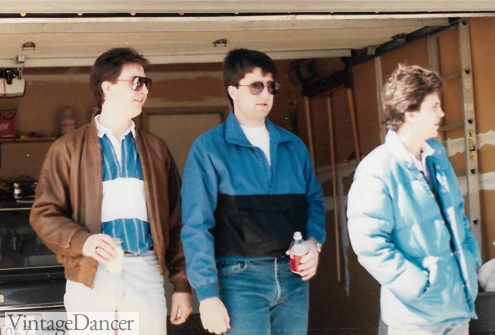
Early ’80s men’s jacket styles, L to R: leather jacket, color-block windbreaker, puffer jacket
Another popular jacket style in the ’80s was the windbreaker. Nothing screams ’80s quite like a brightly color-blocked nylon windbreaker. They were often sold as a set with pants or shorts for athletes, but later sold as separates for everyday wear. Windbreakers zipped up the front and had tie laces that cinched up the collar. Some 1980s windbreakers also had a hood. Shop ’80s windbreaker jackets here.
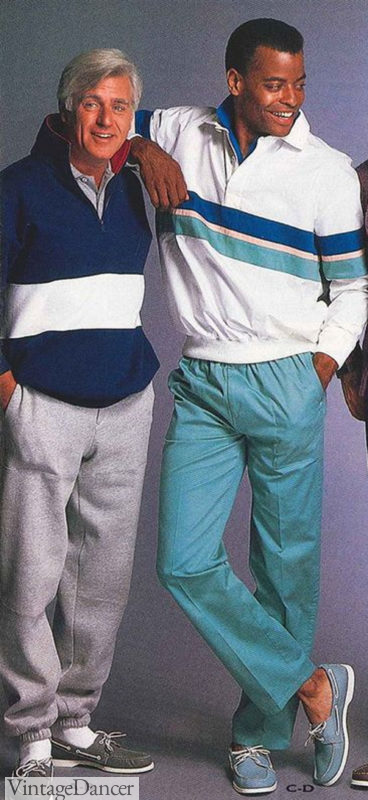
80s mens casual outfits: sweats or windbreaker with cotton pants
For men, the “it” jacket was Members Only by Europe Craft, which can still be bought today on eBay for around $20, or a new reproduction for a lot more. Burgundy was the most popular color, followed by camel brown, grey, and then black. Rich kids owned ones made of genuine leather. It was a cross between a classic golf jacket and a European racing jacket, complete with epaulettes on the shoulders, a tab collar, and small black label with white lettering on the chest pocket that displayed the brand name. Knocks offs were plentiful, at all price points and colors.
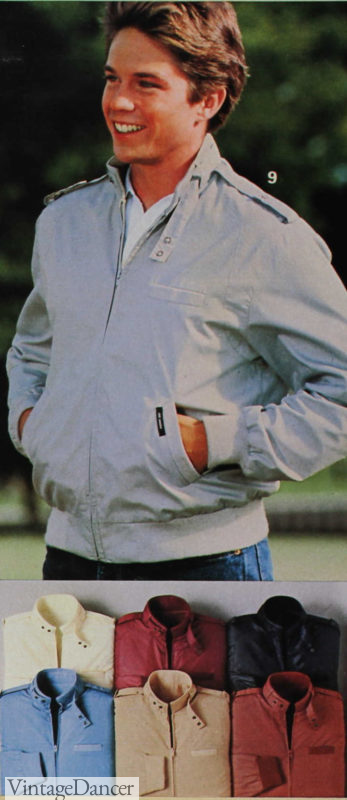
1984 Sears version of a Members Only jacket
To be really cool in the early ’80s, you wore them with parachute pants by brand Countdown and a striped button down shirt underneath. By the late 1980s, though, if you were still wearing one, you were NOT cool.
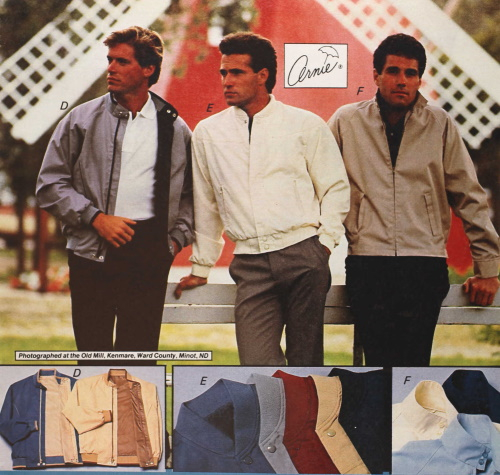
1987 men’s nylon jackets
Other nylon banded bottom jackets could be found in the 1980s worn by young and old alike. The Derby or bomber style was probably the second most trendy for young guys. Harrington jackets or golfers jackets were on trend for mature men, just as they had been since the late 1950s.
Shop all 80s style men’s jackets.
’80s Workout Clothes
Think about men’s workout clothes in the ‘80s and tracksuits are probably the first thing to come to mind.
- 1985 tracksuits
- 1989 color-blocked sweatsuits
Tracksuits were worn by men and women and typically were made of nylon (windbreakers), velour, cotton fleece, or polyester. They consisted of a jacket, usually full zip, and matching pants. Solid colors, or colorblocking in the case of nylon tracksuits, were typical of ‘80s tracksuits. Bright or neon colors were popular, particularly for younger people in the later years. Many tracksuits had stripes down the arms and sides of the legs (think Adidas-style).
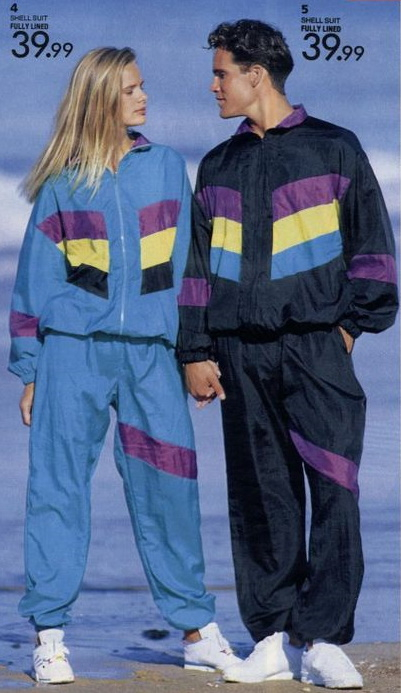
80s nylon shell tracksuits
Fleece sweats came with long pants or shorts and a pullover crew neck or hoodie sweatshirt in solid colors or color block patterns. It was a very ’80s thing to wear sweat shorts over sweatpants. Why? No idea. It seems silly, yet was completely fashionable for the time. Add to any workout outfit a pair of retro stripe white running socks, a sweatband, and sneakers, and you have an iconic 80s gym outfit.
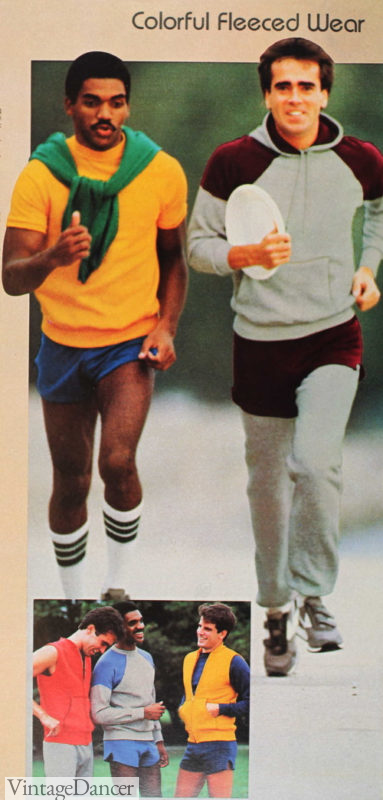
R. Fleece sweats with layered shorts L. Knit mock neck shirt and running shorts. Bottom: Sleeveless sweatshirts
The standard workout outfit for men was shorts and a t-shirt. The shirt could be plain or have decoration in the form of stripes, contrasting trim, or graphics. Shirts came in crew neck and v-neck styles, sleeveless, tank top, crop tops and vests. Men could layer them with any combination they liked.
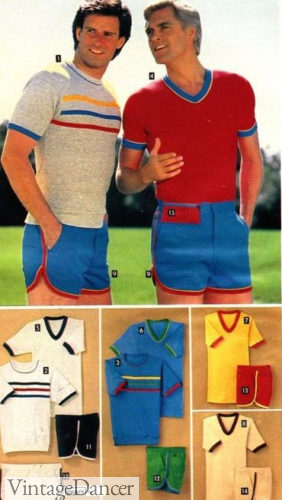
1981 men’s workout tees and dolphin shorts
Workout t-shirts were frequently worn with another ‘80s fitness staple — dolphin shorts. Dolphin shorts were very short nylon shorts with an elastic waistband, contrasting trim, and rounded edges. This style of shorts was worn for both workout and casual wear, and can still be purchased today.
Shop 80s men’s workout clothes and tracksuits.
Men’s swim trunks in the ‘80s closely resembled workout shorts or boxer shorts with their short length, elastic waist, and contrasting trim. Longer drawstring shorts in tropical prints or Jams came in style on the beach of California. At the pool, serious swimmers wore Speedo type swim briefs. Shop men’s retro swimwear.
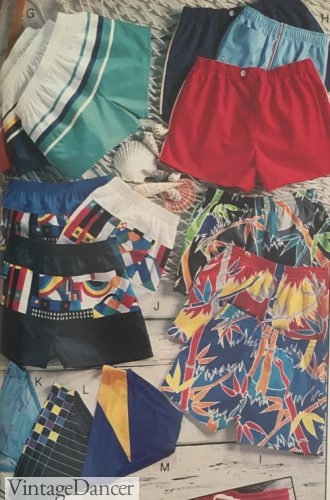
1987 men’s swim trunks
1980s Men’s Shoes
Men in the ‘80s still wore many of the shoe styles of the previous decades. Loafers, Oxfords, and moccasins were all widely worn as semi- dressy to casual shoes. Penny loafers without tassels were worn by young men with pants or jeans. Mature men liked the tassel loafer, and wore them with suits in professional settings (this is what my Dad wore). Preferred colors were very dark brown and black.
Casual loafers in suede or colored leather were more common in the later years. Lace up Oxfords, moccasins, and penny loafers were made in these new colors and materials and could be worn to match or contrast with the colorful outfits of decade.
Additionally, boat shoes such as Sperry Top-Siders were a prominent choice for summer and those who favored the Ivy look. Worn without socks, they were paired with jeans in brown tones or colored pants in white, navy blue, or light shades.
- 1984 men’s business shoes- oxfords, loafers, ankle boots
- 1984 men’s penny loafers and boat shoes
- 1987 mens slip on loafers
- 1986 casual loafer, slipon, and laced shoes
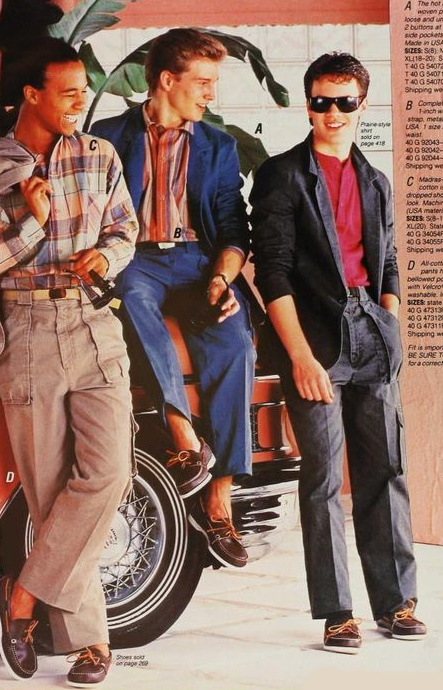
1986 casual outfits with boat shoes, no socks.
1980s Men’s Boots
Men’s boots in the ‘80s fit into one of two categories: practical and fashionable. Practical boots, which made up the majority of the offerings, were made for a specific market or purpose (i.e., hiking boots, logger boots, lineman’s boots). Traditional workwear boots had heavy soles, contrasting laces, and some newer color option (buckskin, burnt red, tan, black). Hiking boots followed the same color patterns. The “safari look” of the decade favored these lace up boots for all day wear.
- 1984 men’s boots
- 1987 men’s work boots
People outside of the target market did purchase and wear many of these styles as fashion, but there were also boots produced specifically for fashion as well. Western boots, dress boots, and heeled ankle boots were some of the fashionable boot choices available.
- Western boots were worn with the Urban Cowboy ’80s look – Denim jacket, Levi’s jeans, western shirts, western blazer, etc
- Pull-on Wellington boots were a carry over from the 1960s, favored by casual dressers and western wear oriented men. The tan brown was the best color.
- Ankle boots were alternatives to dressy shoes but could also be western or casual wear with the right detailing. Most ankle boots were dark brown or black with a side zipper and a smooth, shiny finish.
- Engineer boots for motorcycle riders and some rockers
- Combat boots – Classic Doc Martens and black work boots were starting to trend into mainstream fashion but were largely a 90s trend.
- 1982 ankle boots
- 1987 men’s western boots
Athletic shoes
With the athletic craze in full swing during the ‘80s, the athletic footwear market saw substantial growth. Brands such as Nike, Adidas, Reebok, Converse, Puma, and Pony partnered with professional athletes to promote their shoes. With an explosion of new options in colors, brands and styles, it’s fitting that the ‘80s was the birthplace of the sneakerhead movement.
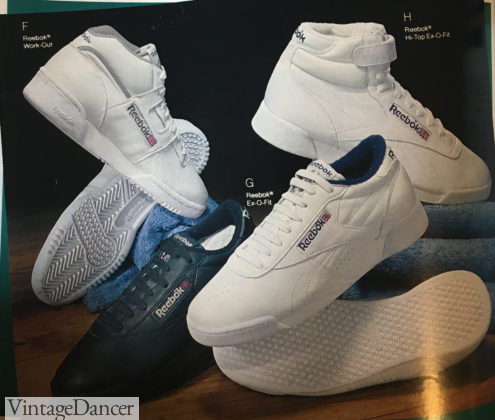
1987 men’s athletic shoes
Besides running sneakers that had multiple color options, most young men who wore sneakers with everyday outfits chose white. White high tops were especially ’80s, but low tops shoes were also options. Branding was everything. The Nike Swoosh, the Reebok tag, N for New Balance, or the check for Pony were displayed across the shoe in bright colors. Shop 80s retro sneakers.
- 1988 men’s athletic and canvas shoes
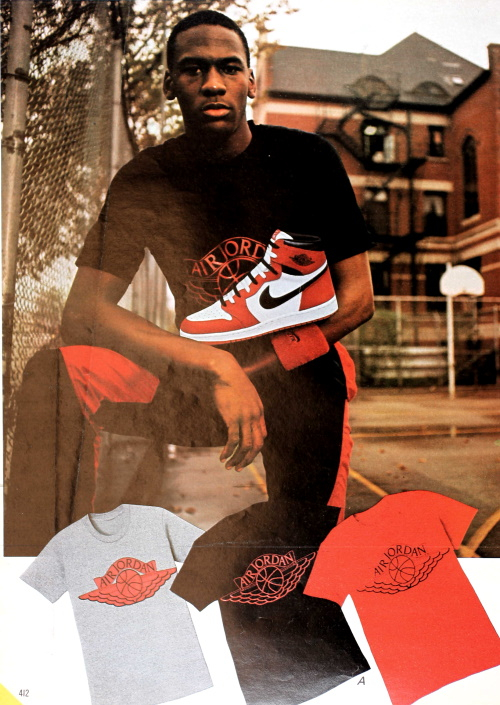
1987 Air Jordan’s were the coolest new shoe to start in the 1980s and dominated the 90s
A more casual alternative to athletic shoes was canvas shoes. Converse and Vans were two of the most popular brands for boys and men; both gained popularity with young people due to being featured in pop culture. Converse’s Chuck Taylor All Stars had a cool but classic feel that made them very popular, particularly with kids and teens. Black was the best until the pop color trend after 1986 caused an explosive of teal, orange, red, yellow, and green shoes. High tops were more popular than low tops, and could be worn fully laced or with the tops folded down.
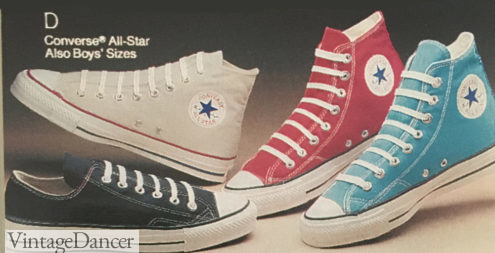
1987 Converse shoes, high and low, in all colors
Vans, previously a niche brand catering to skateboarders, gained mass attention after being worn by Jeff Spicoli in the movie Fast Times at Ridgemont High in 1982. Colorblock patterns, wide stripes/check and checkerboard patterns were trendy and “cool.”
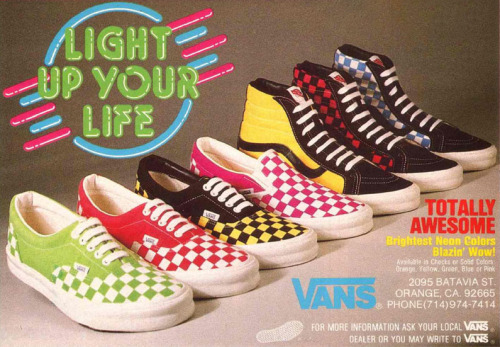
80s Vans in neon colors and classic checkerboard print
Shop all 80s style men’s shoes.
Accessories
Ties
The prominent accessory of the ‘80s businessman, a tie was a way to express personality and style in an otherwise conservative workplace. Ties came in patterns and solids, and most were medium to wide width. Diagonal stripes, wide or narrow, were the most popular tie pattern, although dots, paisley and other patterns were also worn. Knit ties were also in style in the ‘80s. More about the history of men’s ties.
- Knit ties and patterned woven ties, 1989
- Men’s woven and knit ties, 1985
Belts and Suspenders
If you look at all the images on this page, you will see nearly every man is wearing a belt with pants and sometimes shorts. Belts were a major part of all looks in the 1980s. They were needed in the 1970s to hold up tight fitting pants but in the 1980s they were a fashion accessory. Most belts were about 1.25 to 1.5 inches wide. They could be plain leather, embossed “western” leather, braided leather or woven fibers, webbed, or vinyl. Brown, black, and white dominated most belts, but in the summer the two tone woven belts with leather buckles were the preppiest. Also in summer, the military buckle webbed belt fit perfectly with shorts and khaki tone pants.
Belts were not only for mature business men and preppy kids. The silver tipped western style belt was a bit of a trend in the late ’80s with young guys. Brightly colored belts coordinated with other accessories such as sunglasses or canvas shoes. Find 1.5 inch classic belts on Amazon.
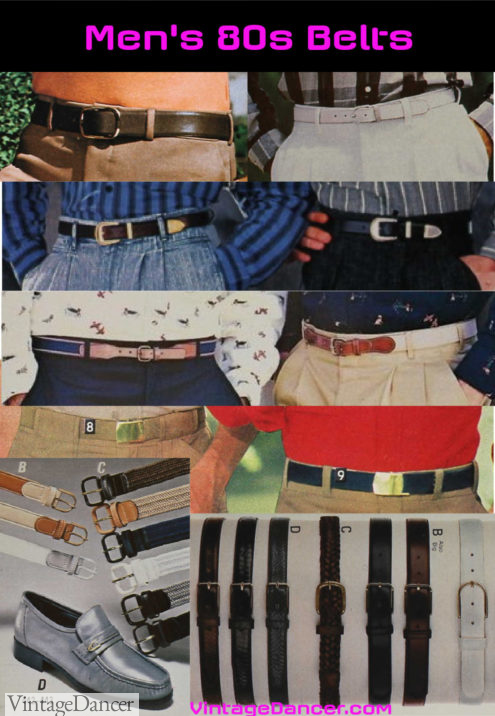
1980s men’s belts- leather, woven, military and western styles
Suspenders (and bow ties) experienced a revival in the 1980s when all things “grandpa” were cool again. Brightly colored suspenders clipped on or buttoned on to matching pants or neutral jeans. They were worn to be visible over white or brightly colored shirts and novelty sweatshirts. Suspenders were (and are) a fun and easy way to make a simple outfit more “Rad.”
- 1987 blue button on suspenders
- 1987 red clip on suspenders with jeans and a winter sweater
80s Men’s Hats
Although hats hadn’t seen regular usage since the ‘50s, the ‘80s resurgence of old styles carried over to a hat revival. Styles such as the fedora, walker, cloth newsboy, leather driving cap, beret, and bowler saw new life atop the heads of celebrities of the era. The Australian outback style hats were on trend with the safari look, as were woven western hats for the cowboys.
Also made popular by celebrities was the bucket hat. Kangol was the must-have brand and was worn by many popular hip hop artists of the era. Legendary artists such as LL Cool J, Eric B. and Rakim, and Grandmaster Flash, each wore Kangol hats. Kangol also made beret caps and newsboy caps. Kangol hats have seen a recent increase in popularity and are still available for sale today.

1986 Kagol hats – Vent-Air cap, Snipe, Spitfire cap
For athletes, it was the tennis visor and the terry cloth sweatband with matching wristbands that become icon men’s headgear. The hip-hop dancers were fond of a twisted or braided sweatbands in the late ’80s.
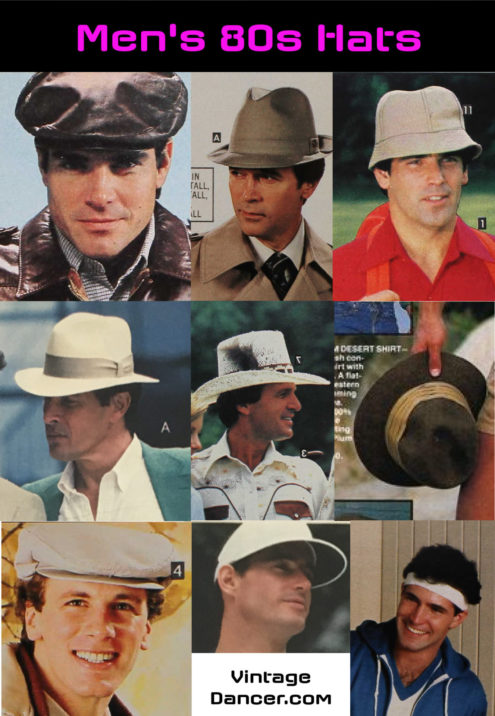
80s men’s hats: leather cap, walker, bucket, fedora, western, safari, cap, visor, sweatband
A summer staple, baseball caps were popular in the ‘80s because of the variety of styles and designs available. ‘8os baseball hats had a mesh back and sides and a stiff front with the team’s logo (aka the trucker hat). I had several for my home team, the Oakland A’s. Buy men’s 80s-style hats here. Or shop eBay for 80s vintage baseball caps.
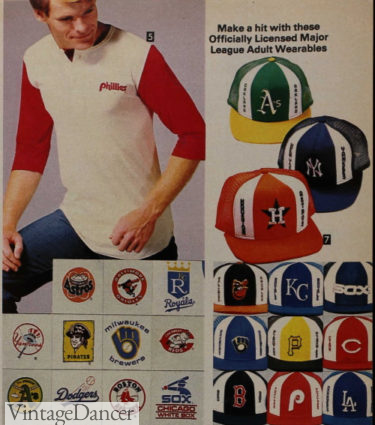
1982 men’s baseball hats for the Major Leagues
Sunglasses
The only way to top your cool look in the ‘80s was with an even cooler pair of sunglasses. Ray-Ban Wayfarers were a perennial favorite, being featured in a variety of movies from Risky Business to The Blues Brothers to Miami Vice. They were a 1950s rock ‘n roll era revival.
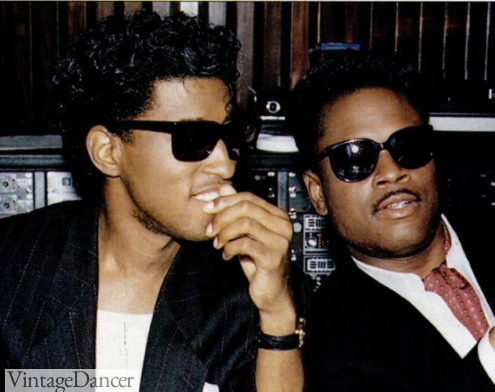
1989 wayfarer sunglasses worn by L.A. and Babyface
Starting in the middle of the decade, CAZAL sunglasses, made popular by Run DMC, were a new and trendy style to wear. Oversized square gold frames and almost bug-eye shaped, they were high end designer sunglasses.
Aviator sunglasses first made in 1936 experienced a major revival after the Top Gun movie placement in 1986. The wire frame and tinted lenses gave everyone a cool masculine edge to them.
Browline-style sunglasses (sunglasses with a thicker upper frame mimicking the shape/placement of eyebrows) were other styles that came back into fashion in the ‘80s. The mirrored ski glasses used the bowline shape to launch a trendy sportswear to street wear look. Many other sunglasses shapes used the rainbow mirror lens.
The mirror flip-up lens glasses/sunglasses worn by character Dwyane Wade in Different Strokes (1987) took a few more years to catch on in the mainstream.
Shutter-style sunglasses (horizontally slatted lenses) in bright plastic frames were another style popularized by ‘80s musicians, but they were more of a fad item than a widespread trend. They later revived in the 2000s as part of hip hop styling.
“New Punk” frames were overlapping triangles of yellow, black or leopard-skin seen in the first half of the decade. You may see these sold as part of ’80s Halloween costumes.
White or brightly colored plastic frames with dark lenses was another late 80s sunglasses fad popular now.
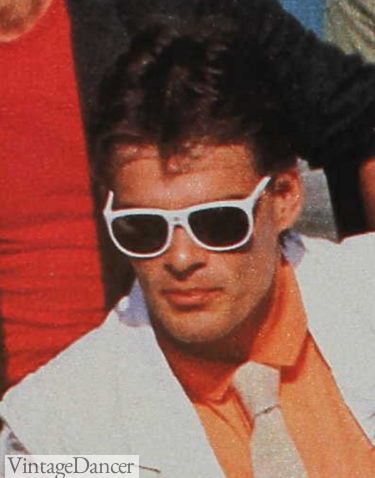
1988 men’s plastic sunglasses
Men’s 80s Jewelry
Men in the ‘80s could also accessorize with a variety of jewelry styles. Large, chunky gold chains started gaining popularity after famous rappers started wearing them. Large pendants and medallions were also worn, and gold link, nugget, or herringbone bracelets were worn as well.
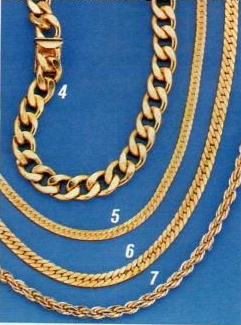
1986 gold chain necklace
Gold rings with diamonds or precious stones were also worn. Mature men usually wore smaller, more understated rings, while younger men could be seen wearing big, flashy gold rings. A single ear piercing was also an ‘80s men’s trend, typically among teens and young men as a sign of rebellion.
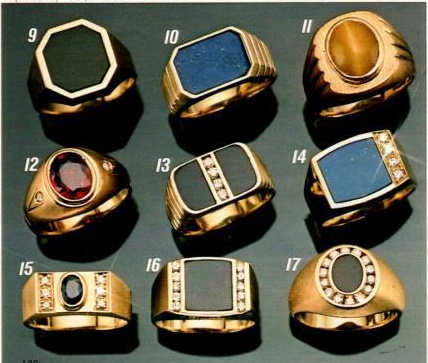
1986 men’s rings
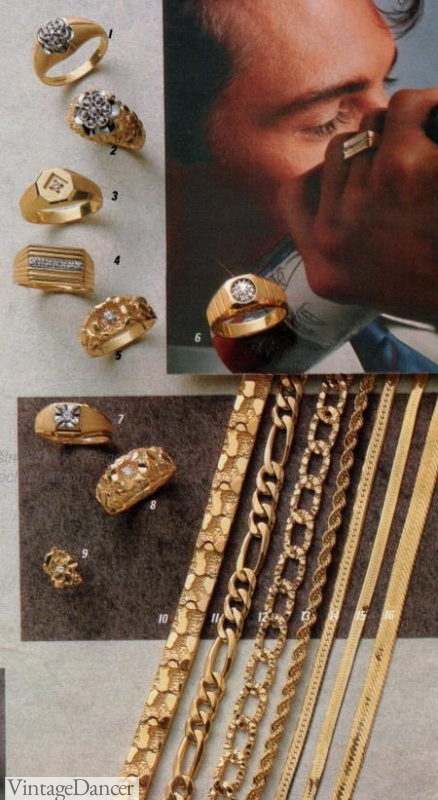
1988 diamond rings and gold chain necklaces
Tie bars, tie tacks, and cuff links were still prevalent in the ‘80s. Most tie bars and tacks came in different shapes and designs, and some had enamel designs on them. They were primarily worn by older men and weren’t as popular with younger men entering the workforce. Although most dress shirts in the ‘80s had barrel cuffs and didn’t need cuff links, a man would typically have at least one pair to wear for special occasions. These were often gold and could be monogrammed. Cuff links were traditionally given as gifts — most men did not buy their own cuff links.
Enamel pins and metal buttons were trendy among teens and young men in the ‘80s, especially when worn on a jacket. These pins could have all sorts of designs and images on them, from sports to politics to popular brands and characters.
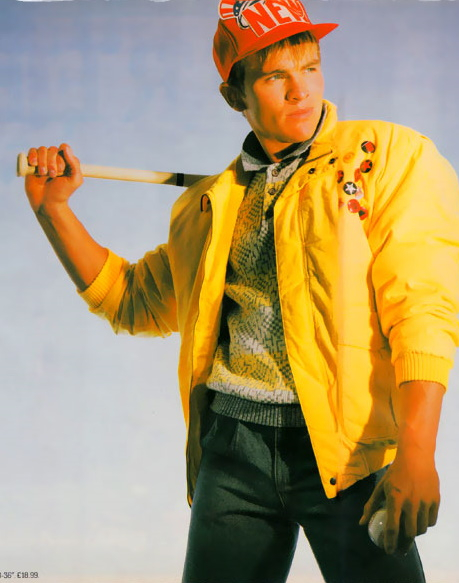
1986 baseball jacket decorated with enamel pins
Always a classic, watches were a staple of the ‘80s man’s accessory collection. Both digital and analog metal watches were available for the mature man, and for the young man and teens, colorful fashion watches made of plastic were available. The ultimate fashion watch for teens was the Swatch watch, which came in a variety of colors, patterns and designs. Wearing a Swatch watch meant you were cool, and wearing multiple Swatch watches at once meant you were extra cool.
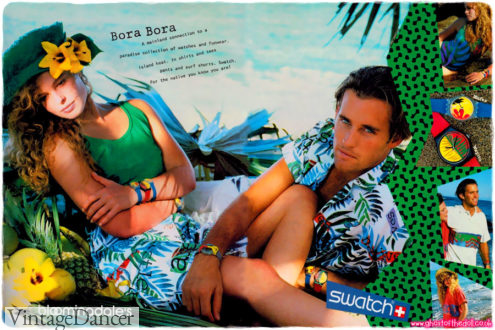
1987 swatch watches- Very cool!
Bracelets were an alternative to watches. They could be a stack of leather tied bracelets or a single metal tennis bracelet. Friendship bracelets, handmade with a pattern of knotted string, were colorful and cool accessories for teenagers and surfers.
And that is a wrap up on 1980s men’s fashion. Need an 80s outfit? We have handpicked some great options to begin your 80s flashback.
Read more: 1980s Party Outfit Ideas for Girls, Guys and Couples
Debbie Sessions has been teaching fashion history and helping people dress for vintage themed events since 2009. She has turned a hobby into VintageDancer.com with hundreds of well researched articles and hand picked links to vintage inspired clothing online. She aims to make dressing accurately (or not) an affordable option for all. Oh, and she dances too.
